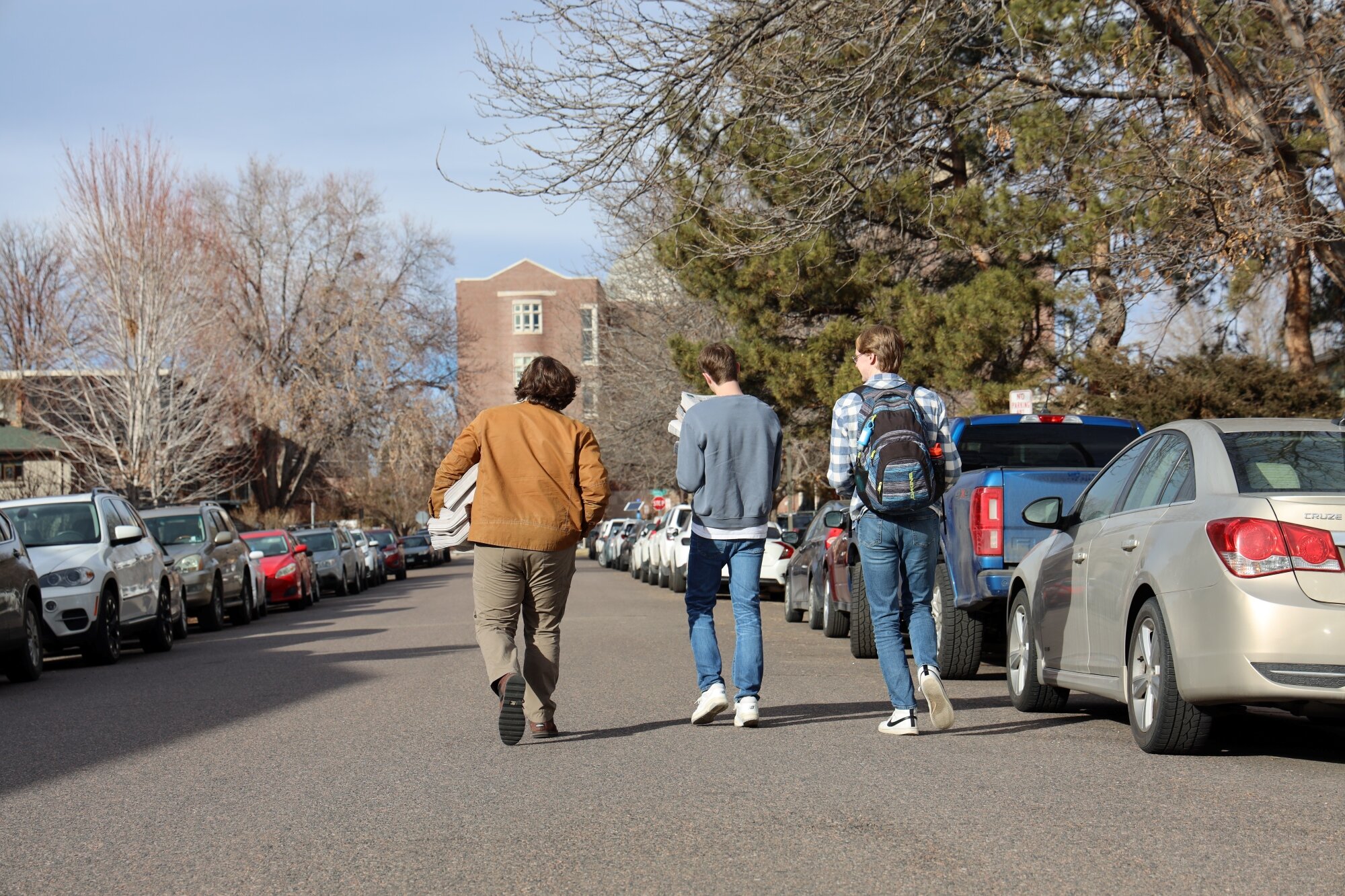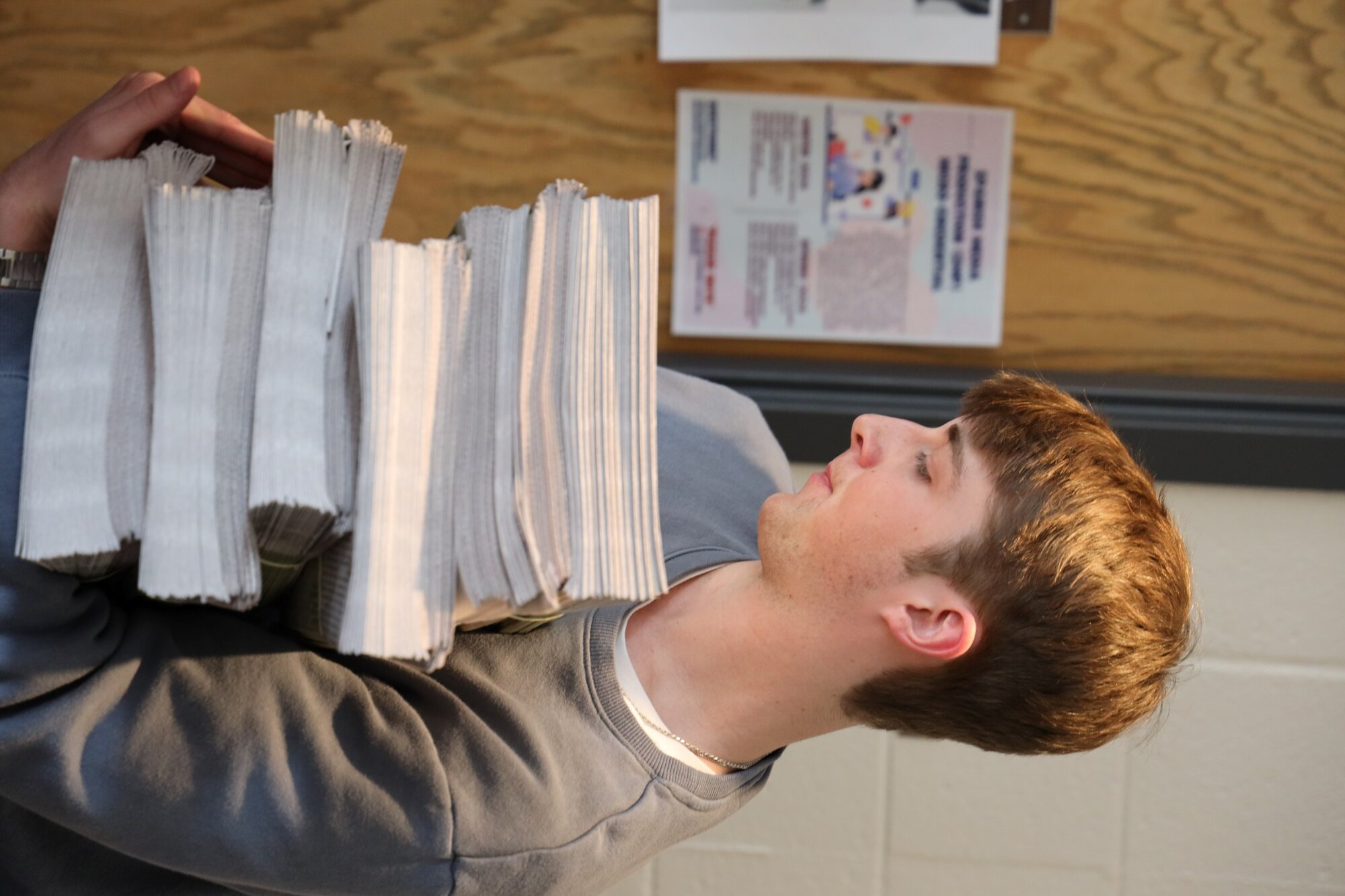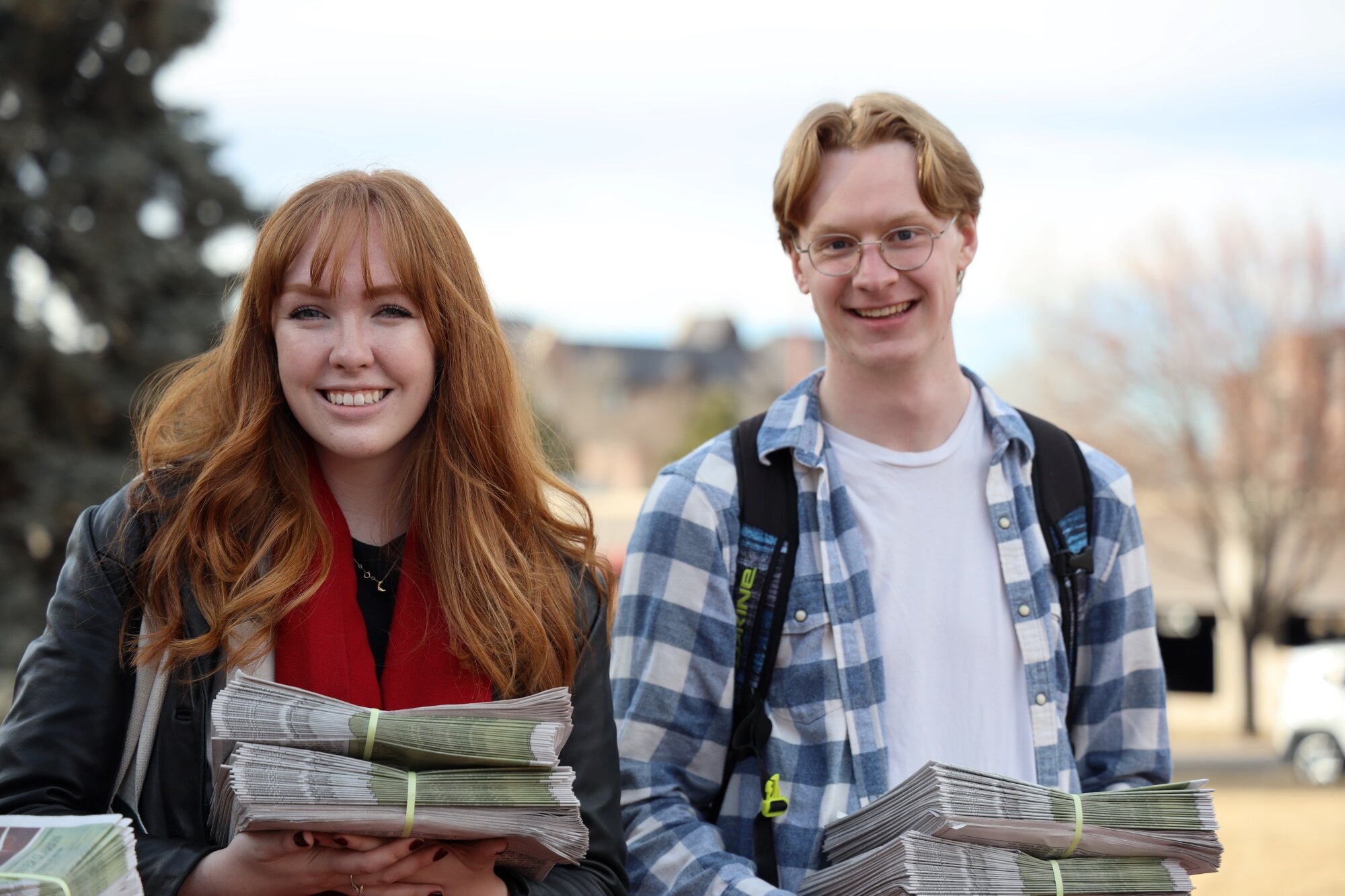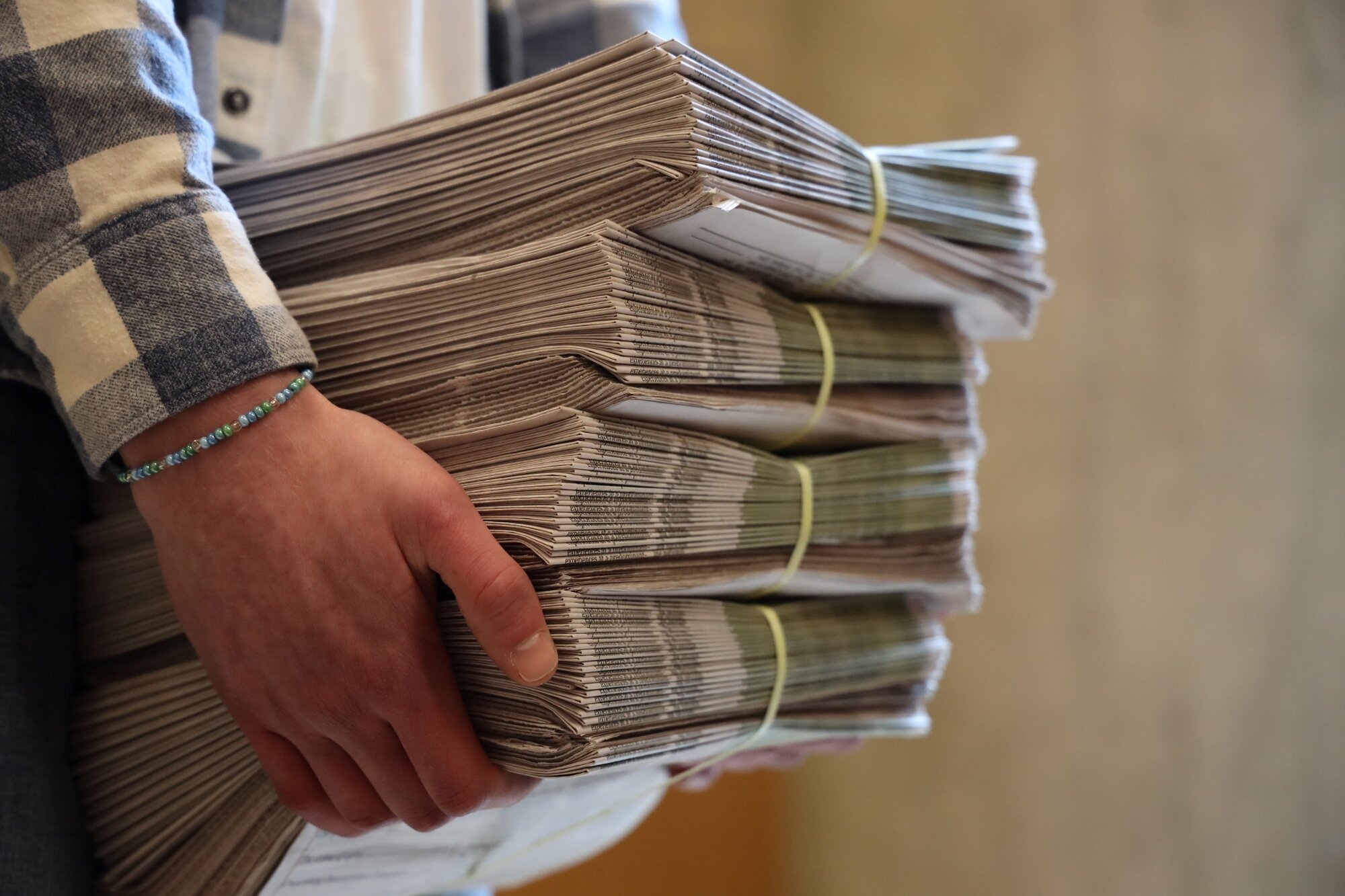Student journalists revive print edition of the DU Clarion

DENVER — Aubrey Cox walked up the middle of South Gaylord Street toward the University of Denver’s main campus. Tucked under his left arm was the culmination of more than a century of history.
Cox is the editor-in-chief of the DU Clarion, the student-run newspaper. This year, the same year the paper will celebrate its 125th birthday, the Clarion is returning to print after a four-year hiatus.
Cox, whose duties also include delivering the paper, believes the revival of print media came at a pivotal time.
“I'm hopeful that student media like the Clarion can encourage students to participate in elections, especially one as important as is coming in 2024,” said Cox, a senior journalism student.

From left to right: Aubrey Cox, sports editor Riley Laub and copy editor Mason Wageman deliver issues of the Clarion.
Photo: Kyle Cooke, Rocky Mountain PBS
From 1986 to 2022, American voters ages 18-29 have, without fail, voted at the lowest rate of any age group.
Political scientists have theorized that the low turnout is due to things like “alternative participation” — that is, younger people are more likely to sign petitions or protest compared to older generations. They still participate in democracy, but that may not involve voting.
Cox also thinks that the press, as a whole, does not always keep students and young people in mind with its coverage.
“The traditional media isolates students and college-age individuals from feeling like they can make a difference,” he said. This is where the Clarion comes in.
The paper’s election coverage features news, analysis and opinion. In a January article, contributing writer Elsie Buczkowski wrote “election season can be intimidating, especially for first-time voters in the U.S. — many of whom are college students. Essential information can become confusing and hard to keep up with.” The article detailed key information and deadlines for the 2024 elections, curated for Colorado residents.
Staff writer Hampton Terrell, who provides opinion and analysis pieces for the paper, even reported from the Iowa Caucuses as part of the Clarion’s “Presi-DU-ntial Race 2024” series.
Cox and the rest of the staff hope that physical copies of the Clarion bolster engagement on campus, and beyond.
“I think that hypothetical success comes from somebody picking up an edition of the Clarion, seeing something that matters to them being portrayed in it and deciding that they should be civically engaged,” he said.

Riley Laub holds a stack of the Clarion’s most recent print edition.
Photo: Kyle Cooke, Rocky Mountain PBS
The Clarion has 11 students on its masthead and a bevy of contributing writers. Production meetings take place in person at the Anderson Academic Commons, which is a dramatic shift from the pandemic-era Zoom meetings that were standard when Cox joined the paper his freshman year.
The COVID-19 pandemic was a major reason the Clarion went out of print. The paper ceased printing in 2019 because construction on campus moved the operation from the Driscoll Student Center to “The Hub.” But a few months later, the pandemic shut down much of campus, and the Clarion’s printing pause went from temporary to indefinite.
“It was a disappointing fact to not have a student newspaper in print. That was something that we had had in high school,” Cox said. “And it's kind of a historic tradition that we wanted to reignite.”
The Clarion is utilizing a nameplate from a 1962 edition of the paper that the staff found in the university’s archives.
Working with a printer based in Cheyenne, Wyoming, the paper prints twice a quarter. Each print run results in 1,000 copies. Cox said the most recent print cost them about $1,100. Funding for the paper comes from a combination of print and digital advertisements, as well as an allocation from the Student Activity Fees.
The staff uses a sort of guerilla marketing, dropping papers wherever they might be most visible to students. While delivering the latest batch of copies to the library Cox and his coworkers were pleased to see that many of the past issues appeared to be popular. The racks were empty.
“It’s really exciting to have something you can hold in your hands,” said Ambriel Speagle, the executive editor. “A lot of people, I feel like, are reading what we put out more now because it’s in very visible places and it’s just easiest to pick up a copy than take your time to go to a website.”

Ambriel Speagle and Mason Wageman pose for a photo with the most recent print edition of the Clarion.
Photo: Kyle Cooke, Rocky Mountain PBS
Student media is often not taken seriously. The journalists are given small budgets, limited access or treated like just another eccentric campus club (DU offers clubs dedicated to both pancakes and hacky sacks, for example). But journalism is journalism, no matter who produces it, and student reporters across the country have been on the front lines of major stories in recent years.
Students at Townsend Harris High School in Queens uncovered a sexual abuse scandal.
The Daily Northwestern’s reporting on hazing resulted in the resignation of head football coach Pat Fitzgerlad. The staff of the Harvard Crimson consistently broke stories about the school’s leadership crisis, all while studying for finals.
“We've had several stories broken that are impressive,” Cox said of the Clarion. The one that stands out the most, he said, is the Clarion’s article in the spring of 2023 about Chancellor Jeremy Haefner receiving a six-figure pay increase while lower-level faculty and staff battled through pay cuts or pay freezes.
“Every once in a while, if a professor learns that I'm on the Clarion, they'll be like, ‘Oh, did you guys break the story?’ And of course, it's not the most comfortable thing to talk about since they're the obvious victims in that situation. But it's been cool to be that investigative force as well,” Cox said.
The Clarion leaves plenty of room for fun, too. Copy editor Mason Wageman is now heading the “poetry and prose” section and Cox joked that a major reason he wanted to return to print was to feature the paper’s crossword puzzle.
“It's really nice producing in that medium because it only gives you so much space. So you're really looking for the cream of the crop,” Cox said. “And each time we print, each time we produce the layout, it's a very satisfying, curated product full of our best work. So that's been very cool."

Kyle Cooke is the digital media manager at Rocky Mountain PBS. Kylecooke@rmpbs.org.
Peter Vo is a multimedia journalist at Rocky Mountain PBS. Petervo@rmpbs.org.